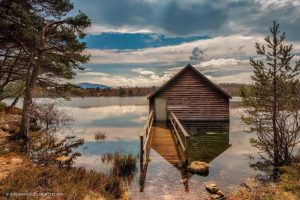Hello my wonderful readers,
Scotland is known for having some of the biggest and deepest lochs in the whole wide world. Apart from their size, their beauty draws you in and captivates you.
But they also hold mysteries that can be hidden away for centuries. And what happens when the lochs dry up? The mysteries are unveiled, and we get a glimpse of how the world used to be, decades, or even eons ago!

Loch Monar drowned landscape. Image source.
Loch Monar
Loch Monar is a freshwater loch situated at the head of Glen Strathfarrar, in the West Highlands of Scotland. Since the 1960s, it has been dammed as part of the Affric-Beauly hydro-electric power scheme.
Due to exceptionally dry weather during the summer of 2015, the water levels dropped so low that a drowned landscape emerged, something that was not visible for over two decades at least.
You could see tree stumps, a whole forest of them, that had been cut down and preserved by the water of the loch, all the way from 1960. Loch Monar had been lengthened and raised, due to the building of the Monar Dam. Many protested the building of that dam, since loch Monar was one of the last glenns untouched by civilization. Fascinating, isn’t it?!

A road and bridges were revealed when water levels fell at Loch Glascarnoch. Image source.
Loch Glascarnoch
The depths of this loch have given up their secrets once again – unveiling roads and bridges used only 60 years ago.
Loch Glascarnoch is a man-made reservoir which was flooded in Ross-shire back in the 1950s. After a particularly dry spring, the water levels fell so low, that the old road between Dingwall and Ullapool emerge from the depths – with sections totalling more than two kilometres now exposed, complete with old passing places still clearly visible.
Pottery shards and old glass bottle remains were visible in many parts of the ‘house’. A previous passer-by had placed some of them on the remains of the old wall, as well as a horseshoe (could it have once been nailed above the entrance door?). Image source.
Even two bridges found themselves in daylight again along with old stone boundary walls, and even the outline of what appears to be a former croft house swamped by the reservoir.
Imagine walking along this road again, after decades of it being unused…It’s a little chilling, isn’t it?

Loch Vaa at its usual water level. Image source.
Loch Vaa
This loch’s water levels dropped to their lowest in 750 years, back in 2019 (feels so long ago, now, hahah!). It had been mysteriously losing water for more than two months. One of the people living there and renting their famous, usually water-lapped, boathouse, had actually described it as “someone pulling the plug of the loch”. While a morbid thought in general, I must admit, it was quite hilarious!
Archaeologists were asked to check for any impact on a crannog, an ancient fortified settlement, in the loch. Just below the water’s surface they found pieces of wood that had survived since the 13th Century. The birch, a species of tree “not known for being particularly robust” according to the archaeologists, was dated back to the 13th Century.
However, this could easily be destroyed by the weather elements, as long as exposure to the sun.
Thankfully, the water levels have since returned to normal in all these lochs!
How fascinating that whole worlds could be hidden underwater, and we would be none the wiser, until something dried the place up? It is awful, however, to think that these are the results of climate change and human activity…
What do you think was at fault here? Did you like the article, my dear?
Let me know in the comments!
Until next time…
Written by Eloise Madigan

 Share this book
Share this book